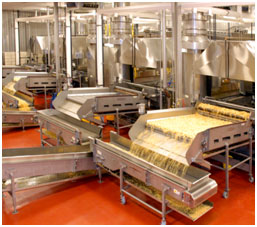For Immediate Release
Exploring the Enduring Popularity of Hard Bite Chips
When it comes to savory snacks, few can rival the iconic status of potato chips. As the upcoming Anuga Foodtec India2024tradeshow in Mumbai, India approaches — Heat and Control, a global leader in snack processing equipment — delves into the rich history and enduring popularity of batch fried potato chips, a cornerstone of the snack industry.
Within this lucrative category, one crunchy contender continues to steal the spotlight. With their signature crunch and seemingly endless flavour varieties — hard bite chips are an enduring consumer favourite. But what’s the secret to their enduring popularity — and what is it exactly — that makes them so very special?
The answer begins with their cooking method. This type of potato chip undergoes a traditional cooking process known as ‘batch cooking’ or batch frying, and whether you know them by‘hard bite’, ‘kettle-fried’ or ‘kettle-style’— the signature crunch is the same.
Origins of batch cooked potato chips
Long ago, in the time before commercial production, potato chip lovers used the batch cooking method at home. They’d slice up their own small batch of potatoes — before lowering them into a kettle of hot oil — taking them out to drain them off — then repeating the process. In those days, the vessel people used to cook their small batches of potato chips was a kettle shape, and this is where the term ‘kettle chips’ or ‘kettle cooked’ originated. This rustic cooking method achieved a distinct taste and texture — which is much the same now — as it was then.
In modern-day potato processing, the commercial batch fryer is an industry workhorse. They’re known as an economical frying solution for high volume production of batch-fried potato chips, French fries, prepared foods, meat, poultry and seafood and meat alternative products.
A batch fryer from Heat and Control produces superior quality products with a long shelf life. This equipment offers years of efficient, reliable service, with a small footprint, which makes them ideal for entry level or start-up brands, or established snacks processors looking to expand their product lines.
Batch Frying vs Continuous Frying
Several factors differentiate a batchfried potato chip from a regular potato chip. While regular potato chips are known for being mass produced, most consumers associate batchfried varieties with a smaller more ‘artisan’ cooking process. The regular style of potato chip is made using a ‘continuous frying’ method that focusses on speed and efficiency. In this method, potato slices are continuously fed into the equipment and carried through the fryer with circulated oil externally heated to a set temperature before being discharged. Many of the larger players in the potato chip industry are utilising continuous frying to produce regular style potato chips.
By contrast, the process of making batchfried potato chips is significantly different. To start with, the potato slices used are typically thicker, and as the name suggests these potato chips are cooked in individual batches. An inherently longer process than continuous frying, batchfried potato chips are cooked in small batches, at much lower temperatures than regular potato chips. It’s a slower, more traditional cooking method which sees the chips spend more time in the oil with a specified controlled temperature profile through the batch cook cycle.
While the process of batchfrying potato chips is certainly longer, it is the slower cooking process that achieves the unique texture and signature crunch consumers love. Not washing the potato slices prior to frying (allowing starch to remain on the surface of the slices) is what allows the traditional ‘home-made’ appearance of batchfried chips to develop.
Innovations in Sustainable Snack Processing
Strong consumer preference for potato chips with characteristics such as firm texture (hardbite), natural ingredients and the association of a more artisancooking process make batch fryers a favoured choice for production.
However, the efficiency of traditional pan-fired batch fryers, which tend to consume more fuel per kilogram of product, compared to modern continuous frying systems, is a key sustainability challenge for potato processors.
Heat and Control National Sales Manager, Venkatesha Parthasarathysays that adoption of innovative technologies and processes can help processors achieve their sustainability goals throughout the production line.
“We’ve developed and manufactured three advanced systems — which allow batch frying to approach the same level of energy efficiency found in the best continuous frying systems — while still preserving the premium product qualities inherent to the batch frying process,” he says.
“Our systems are proven to reduce fuel costs, energy waste, air pollution, and water consumption — to help you process more responsibly, while benefiting the environment and your bottom line.
An excellent example of Heat and Control’s commitment to sustainable food processing are their Booster Heaters. These innovative devices reuse waste gases to boost production efficiency and cut energy costs, all while reducing carbon emissions. Whether as a new addition, or retrofitted to existing batch-fried style fryers, they can reduce energy use by upto 30%. Embracing such technology translates into real benefits for businesses, including significant cost savings and a smaller environmental footprint.
“By embracing new technologies, processes, and strategies, potato processors can enhance efficiency, improve product quality, while respondingquickly to consumer preferences and market dynamics.”
As a global leader in snacks processing equipment, Heat and Control has fast, high-performance, and sustainable equipment solutions for every aspect of your snacks production line, along with innovative problem-solving approaches. Want to know more? The business will showcase their latest and most innovative snack food equipment solutions in Mumbai, Indiaat the Anuga Foodtec India tradeshow 28 – 30 August, 2024 on stand #C14.

About Heat and Control
Established in 1950, Heat and Control is a privately-owned company with a global team that has built an extensive knowledge bank and developed a wealth of experience and expertise. Access to production and technical support from a network of engineers, food technicians, field service technicians, skilled tradespeople, and support teams provide food manufacturers with confidence to achieve production goals.
• Eleven manufacturing facilities, 10 test centres, more than 30 offices globally
• Testing, design, engineering, manufacturing, installation commissioning, user training, spare parts, and provision of after sales service.








